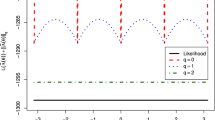Abstract
The paper aims to develop a mathematical model of consumer demand observed over a certain number of years. Compression (reduction) of a large amount of data in a mathematical model to compact mathematical objects—matrices and their eigenvectors—allows one to make certain conclusions about the general set of consumers in several markets at once. The basic mathematical apparatus used is Allen’s approach, also known as the best average percentage. The research is based on one of the varieties of the ordinary least squares method (OLS). The paper considers the possibility of detecting the presence of periodicity in consumer demand. A mathematical criterion for accepting or rejecting assumptions about periodicity is also proposed. The proposed meta-mathematical model allows us to process large data sets on consumer demand of past periods and predict the periodicity of demand.
Access this chapter
Tax calculation will be finalised at checkout
Purchases are for personal use only
Similar content being viewed by others
References
Allen, R. G. D. (1960). Mathematical economics (2nd ed.). Macmillan and Co LTD; St. Martin’s Press.
Allen, R. G. D. (1980). Index numbers in theory and practice (L. S. Kuchaev Transl. from English). Moscow, USSR: Statistics. (Original work published 1975).
Dubrov, A. M., Mkhitaryan, V. S., & Troshin, L. I. (2003). Multivariate statistical methods. Finance and Statistics.
Ermilov, M. M., Surkova, L. E., & Samoletov, R. V. (2021). Mathematical modeling of consumer behavior, taking into account entropy. In A. V. Bogoviz, A. E. Suglobov, A. N. Maloletko, O. V. Kaurova, & S. V. Lobova (Eds.), Frontier information technology and systems research in cooperative economics (pp. 269–278). Springer. https://doi.org/10.1007/978-3-030-57831-2_28.
Green, W. H. (2002). Econometrics analysis (5th ed.). Prentice-Hall.
Green, W. H. (2016). Econometric analysis (Book 1) (A. V. Khodyrev, A. S. Stepanov, & B. N. Gafarov Transl. from English; S. S. Sinelnikov, & M. Yu. Turuntseva Eds.). Publishing House “Delo,” RANEPA.
Intriligator, M. D. (2002). Mathematical optimization and economic theory (G. I. Zhukova, & F. Ya. Kelman Transl. from English). Iris-Press. (Original work published 1987).
Kleiner, G. B. (2017). System fundamentals of the digital economy. In International Theoretical and Practical Conference “Institutional and Financial Mechanisms of Formation of Digital Economy.” Dubna, Russia: Dubna State University.
Magnum, Ya. R. Kamyshev, P. K., & Peresetsky, A. A. (2021). Econometrics (9th ed.) Publishing House “Delo,” RANEPA.
Rao, C. R. (1968). Linear statistical inference and its applications (A. M. Kagan Transl. from English; Yu. V. Linnick Ed.). Moscow, USSR: Nauka. (Original work published 1965).
Romer, D. (2001). Advanced macroeconomics (2nd ed.). McGraw Hill.
Ryazanova, G. N. (2021). The system of interaction with the consumer in a modern organization. In G. B. Kleiner, & S. E. Shchepetova (Eds.), Systems Analysis in Economics—2020: Collection of the 6th International Research & Practice Conference-Biennale SAE-2020 (pp. 188–191). https://doi.org/10.33278/SAE-2020.book1.188-191.
Taha, H. A. (2019). Operations research: An Introduction (10th ed.) (A. A. Minko, & A. V. Sleptsov Transl. from English). Dialectics. (Original work published 2016).
Tyurin, Y. N. (2011). Multivariate statistics: Gaussian linear models. Moscow University Press.
Author information
Authors and Affiliations
Corresponding author
Editor information
Editors and Affiliations
Rights and permissions
Copyright information
© 2023 The Author(s), under exclusive license to Springer Nature Switzerland AG
About this chapter
Cite this chapter
Ermilov, M.M., Bityuckiy, S.Y., Kudryavtseva, L.G., Surkova, L.E., Boltaevskiy, A.A. (2023). Mathematical Model of Consumer Demand. In: Bogoviz, A.V. (eds) Big Data in Information Society and Digital Economy. Studies in Big Data, vol 124. Springer, Cham. https://doi.org/10.1007/978-3-031-29489-1_9
Download citation
DOI: https://doi.org/10.1007/978-3-031-29489-1_9
Published:
Publisher Name: Springer, Cham
Print ISBN: 978-3-031-29488-4
Online ISBN: 978-3-031-29489-1
eBook Packages: Intelligent Technologies and RoboticsIntelligent Technologies and Robotics (R0)




